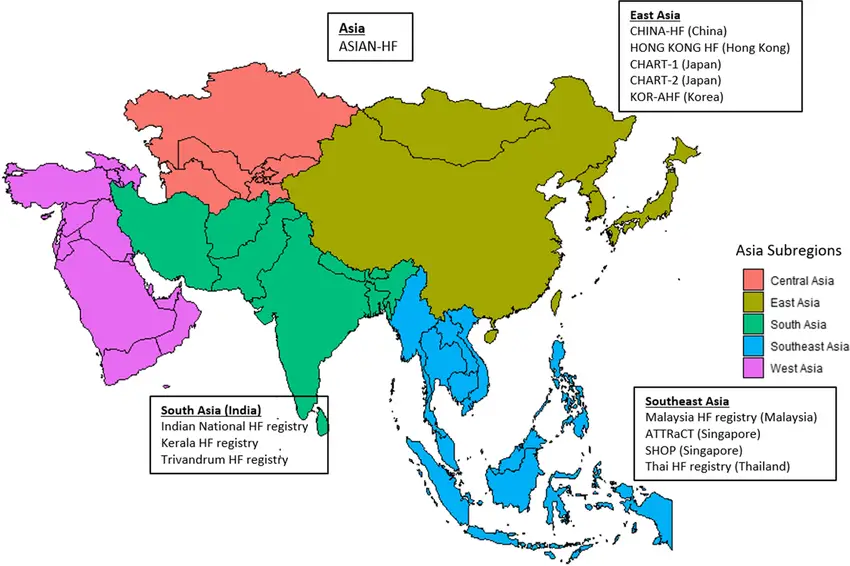Asian cuisine is as diverse as the continent itself. It stretches from the arid deserts of the Middle East to the tropical islands of Southeast Asia. This vast region is home to a myriad of flavors, techniques, and ingredients. Each has a long history that stretch back millennia.
In this article, we will explore the countries that make up Asia. We also look at the main characteristics of Asian cooking, the geographic and climate features that have influenced it. We also look at the main ingredients used in Asian recipes. Following this we consider the health aspects of Asian cooking.
From this article you can link to every Asian country and read about their cuisine. Please try the many recipes that we include.
The Countries that Make Up Asia
Asia is the largest continent on Earth, comprising 48 countries, each with its own unique culture and culinary traditions. These countries group into regions:
- Central Asia
- East Asia
- South Asia
- Southeast Asia
- Western Asia (the Middle East).
Each region offers a distinct culinary experience that reflects its history, culture, and resources. From the sushi of Japan to the curries of India, the kebabs of Turkey to the dim sum of China.
The Main Characteristics of Asian Cuisine

Asian cooking is characterized by its emphasis on balance — the balance of flavors, textures, and colors. It often strives for a harmony between sweet, sour, salty, bitter, and umami flavors.
Freshness is also a key characteristic, with many Asian cultures emphasizing the use of fresh vegetables, meats, and seafood. Cooking techniques vary widely across Asia.
These include the stir-frying and steaming of Chinese cuisine. This contrasts against the grilling found in Korean and Japanese cuisines. In turn these differ from the slow simmering of stews in Indian and Middle Eastern dishes.
The Geographic and Climate Features that Have Influenced Asian Cuisine

The geography and climate of Asia have greatly influenced its cooking methods and ingredients. The fertile river deltas of countries like Vietnam and Thailand have made rice a staple food.
The spice trade historically shaped South Asian and Middle Eastern cuisines, with spices used both for flavor and as preservatives in hotter climates.
The cold climates of northern countries like Mongolia have led to a diet heavy in meat and dairy, while the island nations of Southeast Asia use an abundance of seafood.
The Main Ingredients that Are Used in Asian Cuisine

Rice, soy, and noodles form the carbohydrate foundation of many Asian cuisines. Ingredients like ginger, garlic, sesame oil, rice vinegar, soy sauce, and fish sauce are commonly used to add depth and complexity to dishes.
Spices such as turmeric, cumin, cardamom, and star anise are essential in many Asian recipes, contributing to their distinctive flavors. Fresh herbs, including cilantro, basil, and mint, are also prevalent, providing fresh, aromatic qualities to the dishes.
How Healthy is Asian Cuisine
Asian cooking is often lauded for its health benefits, largely due to its use of fresh ingredients and cooking techniques that preserve the nutritional value of food.
Many Asian diets are plant-based, with a moderate use of meats and a heavy reliance on vegetables, fruits, and whole grains. The traditional Asian diet is low in sugar and high in fiber, which is beneficial for digestive health.
However, some dishes can be high in sodium and certain cooking methods, like deep-frying add to the calorie count.
How Asian Cuisine Has Spread Through the Rest of the World
Asian cuisine has spread globally through various channels, including trade, immigration, and globalization. Dishes like Indian curry, Chinese stir-fry, and Japanese sushi have become staples in many countries around the world.
This spread has been facilitated by the international appeal of Asian cuisine’s rich flavors and often health-conscious dishes. Additionally, the rise of Asian diasporas around the world has led to the opening of authentic restaurants and markets, making Asian cooking more accessible.
The global fascination with Asian cuisine has also been fueled by media, including food travel shows and cooking channels, which have introduced audiences to the vast array of Asian dishes and cooking techniques.
Conclusion
In conclusion, Asian cooking is a testament to the continent’s rich tapestry of cultures, climates, and histories.
Its emphasis on balance, freshness, and harmony in flavors has not only made it a cornerstone of many Asian cultures but also a beloved part of global cuisine. The health benefits of many traditional Asian dishes, combined with the ease of finding Asian ingredients in international markets, have contributed to its popularity worldwide.
As people continue to explore and enjoy Asian cuisine, its influence and presence in the global culinary landscape will undoubtedly continue to grow.
Links to Every Asian Country
The following are links to every Asian country and their cuisine. Recipes of each country are in every article.
- Albanian Food Extravaganza: Uncover 24 Balkan Recipes Now!
- Afghan Cuisine Discover 22 Authentic Afghan Cuisine Recipes
- Azerbaijan Cuisine: Culinary Delights Unveiled
- Bangladesh Food: Taste the Flavors of Bangladesh: 2023
- Bhutan Food: Culinary Marvels Await! Taste the flavor in every bite
- Brunei – The exotic taste of the East
- Cambodia Food: – Explore 20 Authentic Cambodian Recipes
- Chinese Cuisine – A delightful exploration
- Indian Cuisine Savor the Spice as you explore recipes with me
- Indonesian Cuisine and Recipes: Tantalizing Journey
- Japanese Cuisine – Discovering Sushi – The National Dish of Japan
- Kazakhstan Food: Explore 30 Irresistible Recipes
- Korean Food: 22 Authentic and Delicious Recipes
- Kyrgyz Cuisine and its National Food Dishes
- Malaysian Cuisine – A Culinary Journey for Food Lovers!
- Thai Cuisine – Food Bliss: 22 Thais recipes you can try at home
- Turkmenistan Cuisine – Explore the Delights
- Uzbekistan Food Discover its Culinary Secrets with 22 Tasty recipes
- Vietnam Cuisine: A Culinary Odyssey

